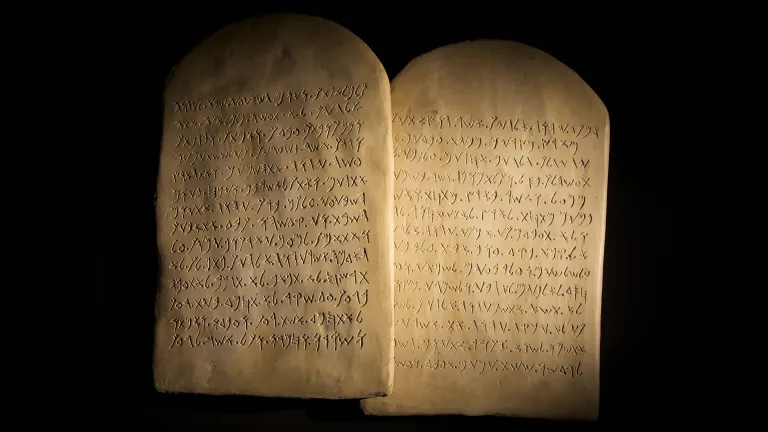Two Tablets of Stone

Many envision the Ten Commandment tablets as each inscribed on one side, with some commands on one tablet and the rest on the other. Is that right? And what is the significance of having two tablets?
We find 15 verses in the Bible that tell us that God inscribed the Ten Commandments on two tablets (tables or slabs) of stone. Being engraved on stone emphasizes the importance and permanence of the Ten Commandments.
But why two tablets rather than one? The answer evidently concerns the role of commandments in His covenant with His people.
All 10 on each, written front and back
Many imagine that some of the commandments were written on one of the tablets, and that the rest of the commandments were written on the other tablet. But as many scholars have concluded, Scripture and historical context appear to indicate that all of the Ten Commandments were engraved on each stone! “The tablets were written on both sides; on the one side and on the other they were written” (Exodus 32:15).
In that case, on each stone, part of the commandments would have been written on one side and the rest on the other. God was certainly able to make the letters small enough to fit all of the Ten Commandments on each tablet, writing front and back!
This would mean that each tablet was a duplicate of the other—so that if one were flipped over next to the other, all the commandments would be visible together.
But why would God form two copies? These tablets represented key terms of the covenant God was making with the people of Israel! A covenant is a binding agreement or contract between two or more parties.
The Bible refers to the tablets as “tablets of the Testimony [or declared witness]” (Exodus 31:18; Exodus 32:15; 34:29) and “tablets of the covenant” (Deuteronomy 9:9; Deuteronomy 9:11; Deuteronomy 9:15). The Ten Commandments were a major part of God’s revelation to Israel and the core terms of God’s contract with Israel.
The New Testament refers to this covenant as the “old” covenant in comparison with the “new” instituted by Jesus Christ (Hebrews 8:13). Various passages connect the Ten Commandments with this covenant God made with Israel (see Exodus 34:28; Deuteronomy 4:13; 1 Kings 8:9; 2 Chronicles 5:10 and Hebrews 9:4).
Importantly, though, the commandments themselves were not the covenant, as these laws existed before the covenant. Rather, the covenant involved the agreement of the people to obey them and all else that God, their Lord and Deliverer, would command.
A copy for each side
Again, though, why two copies? Consider this fundamental fact about the nature of a formal “covenant.” For two parties entering into a legal contract there would normally be at least two copies of the written agreement—one copy for each party to the agreement. Ancient Middle Eastern treaties often required duplicate copies. And it appears that at Mount Sinai, God made one copy of the covenant for Himself and the other copy for Israel! He obligated Himself to the terms of the covenant, and Israel agreed (initially) to be obligated to the terms of the covenant. The covenant was binding on both parties, so each party would own a copy of the terms spelling out their obligations!
God instructed Moses and Israel to protect and carry both tablets in the Ark of the Covenant (Deuteronomy 10:1-5). Note that 1 Kings 8:21 and 2 Chronicles 6:11 speak of the Ark containing “the covenant of the Lord.” These scriptures further support the fact that the Ten Commandments represented the covenant between God and Israel.
Another question is: Why would God’s copy and Israel’s copy both be kept together in the Ark? This arrangement would emphasize the intimate relationship between God and His people. The Ark was holy—it belonged to God. We could perhaps say that God invited Israel to keep its copy in His Ark. What an honor for Israel! And quite practical too—the Ark being the safest place for the preservation of both tablets.
To summarize, it can be surmised that God wrote the Ten Commandments on two tablets because they represented a sacred covenant between God and Israel. Similar to other ancient contracts, one tablet would have been for God, and the other for Israel—each to consider their own commitments and those of the other.
Foreshadowing the New Covenant
In Jeremiah 31, God foretold a New Covenant with Israel, and the New Testament shows God’s intent to expand a renewed Israel to include people of all nations. Rather than this covenant being engraved on stones, Hebrews 10:16 quotes Jeremiah 31 in stating: “This is the covenant that I will make with them after those days, says the Lord: I will put my laws into their hearts, and in their minds I will write them.”
It’s clearly a much “better covenant” for several reasons (Hebrews 7:22; 8:6; and see the companion article “Invited Into Covenant With God!”).
Those who enter this New Covenant with God and remain faithful to it will be rewarded with everlasting life in the Kingdom of God! It entails seeking forgiveness for breaking God’s commandments and, with His help, obeying them. Deeply consider this astounding opportunity!






